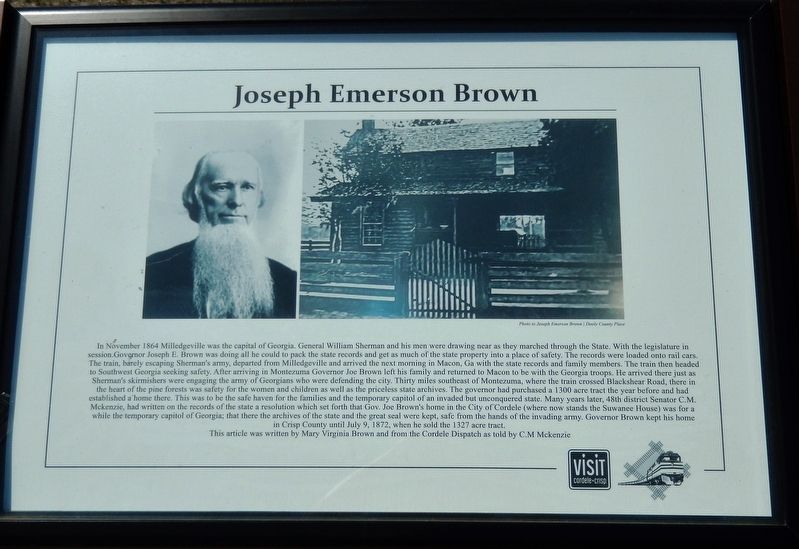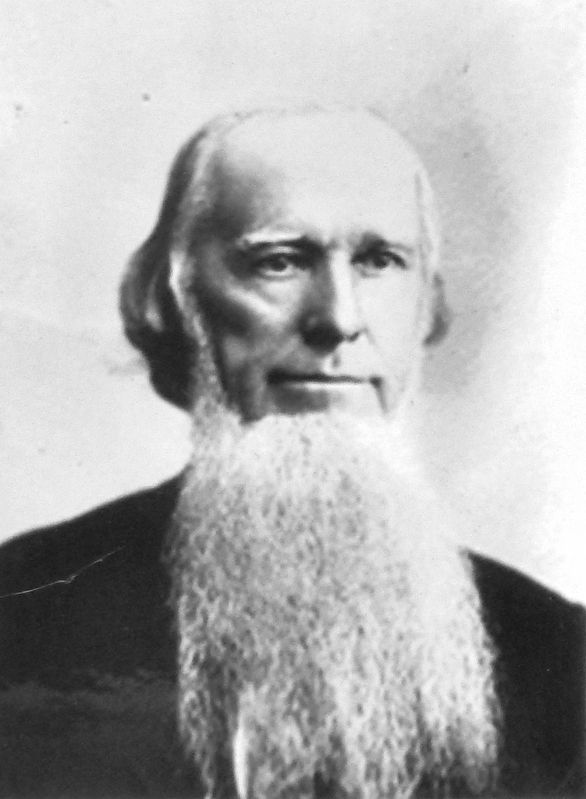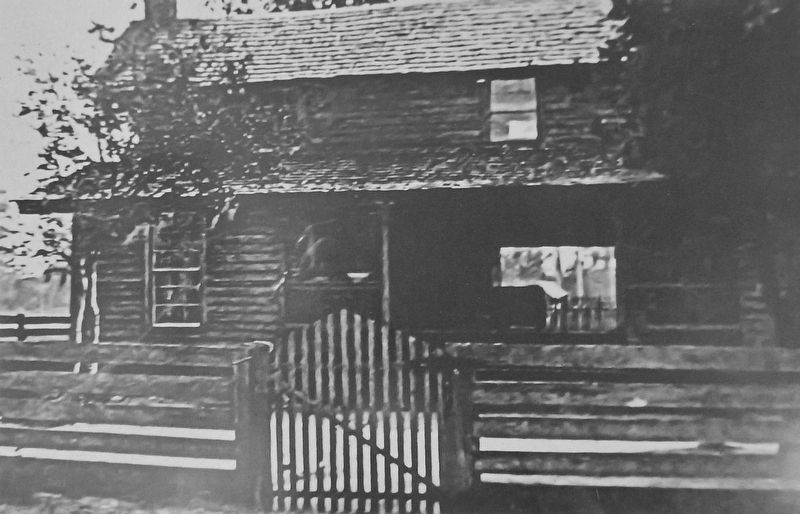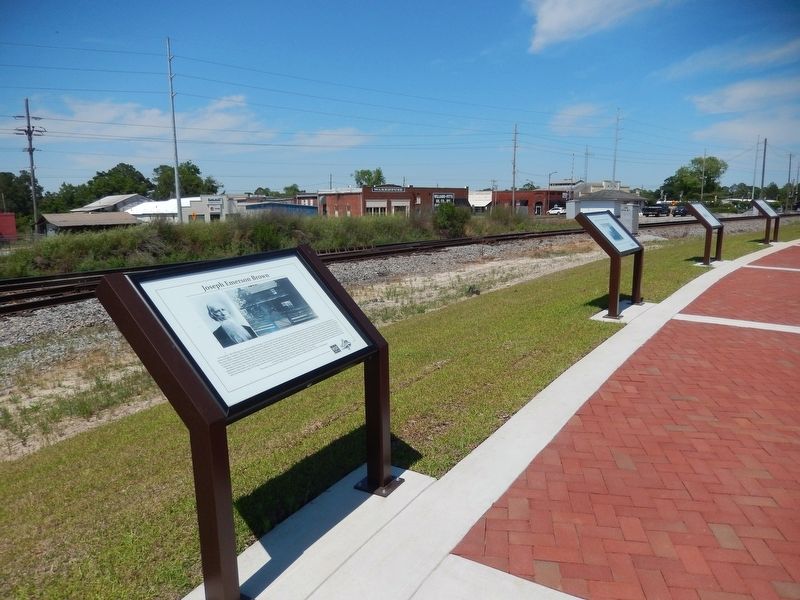Cordele in Crisp County, Georgia — The American South (South Atlantic)
Joseph Emerson Brown
In November 1864 Milledgeville was the capital of Georgia. General William Sherman and his men were drawing near as they marched through the State. With the legislature in session, Governor Joseph E. Brown was doing all he could to pack the state records and get as much of the state property into a place of safety. The records were loaded onto rail cars. The train, barely escaping Sherman's army, departed from Milledgeville and arrived the next morning in Macon, Ga with the state records and family members. The train then headed to Southwest Georgia seeking safety. After arriving in Montezuma Governor Joe Brown left his family and returned to Macon to be with the Georgia troops. He arrived there just as Sherman's skirmishers were engaging the army of Georgians who were defending the city. Thirty miles southeast of Montezuma, where the train crossed Blackshear Road, there in the heart of the pine forests was safety for the women and children as well as the priceless state archives. The governor had purchased a 1300 acre tract the year before and had established a home there. This was to be the safe haven for the families and the temporary capitol of an invaded but unconquered state. Many years later, 48th district Senator C.M. Mckenzie, had written on the records of the state a resolution which set forth that Gov. Joe Brown's home in the City of Cordele (where now stands the Suwanee House) was for a while the temporary capitol of Georgia; that there the archives of the state and the great seal were kept, safe from the hands of the invading army. Governor Brown kept his home in Crisp County until July 9, 1872, when he sold the 1327 acre tract.
Topics. This historical marker is listed in these topic lists: Railroads & Streetcars • War, US Civil. A significant historical month for this entry is November 1864.
Location. 31° 58.199′ N, 83° 47.027′ W. Marker is in Cordele, Georgia, in Crisp County. Marker can be reached from Wall Street West west of 7th Street North (U.S. 41), on the right when traveling west. Marker is located in Cordele Railway Park, overlooking multiple active railroad tracks. Touch for map. Marker is at or near this postal address: 106 Wall Street West, Cordele GA 31015, United States of America. Touch for directions.
Other nearby markers. At least 8 other markers are within walking distance of this marker. Americus, Preston and Lumpkin Railroad (here, next to this marker); Georgia Southern & Florida Railroad (a few steps from this marker); Union Depot (a few steps from this marker); Atlantic & Birmingham Railway (a few steps from this marker); Savannah, Americus & Montgomery Railway (within shouting distance of this marker); Georgia & Albany Railway (within shouting distance of this marker); Georgia Southern & Florida Railway (within shouting distance of this marker); Capitol of Georgia Site • 1865 (about 500 feet away, measured in a direct line). Touch for a list and map of all markers in Cordele.
Related markers. Click here for a list of markers that are related to this marker. Cordele Railway Park
Also see . . .
1. Joseph E. Brown: Capture of Milledgeville. Wikipedia entry:
Gov. Brown, thinking first of the valuable and perishable State property, ordered Gen. Ira Foster, Georgia's quartermaster, to secure its removal. A train of cars was held at the depot to carry off State property. Such was the general terror and the rush to leave town, it was next to impossible to procure labor. When the Governor saw the condition of affairs, he went to the penitentiary, had the convicts drawn up in a line, and made them a short speech; he appealed to their patriotic pride and offered pardon to each one who would help remove the State property and then enlist for the defense of Georgia. They responded promptly, were put under the command of Gen. Foster, and did valuable service in loading the train. (Submitted on May 31, 2021, by Cosmos Mariner of Cape Canaveral, Florida.)
2. Governors of Georgia: Joseph E. Brown (1821-1894). New Georgia Encyclopedia website entry:
The Confederacy collapsed in April 1865. Governor Brown was arrested and briefly imprisoned in Washington, D.C. Paroled, he backed U.S. president Andrew Johnson's Reconstruction policy and received a full pardon in September. Then a Republican, Brown served as chief justice of the Supreme Court of Georgia for two years. As Reconstruction ended, he swung back to the ranks of the Democrats and again prospered in law and business. Brown amassed tremendous wealth from his reliance on the state’s convict lease system. Hundreds of African American convicts, many of whom were arrested for trivial offenses, were made to labor under deplorable conditions in Brown’s north Georgia mines. (Submitted on May 31, 2021, by Cosmos Mariner of Cape Canaveral, Florida.)
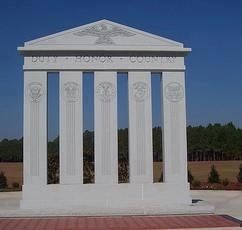
via City of Cordele, unknown
4. History of Cordele
City website entry:
During the last days of the Confederacy, Georgia's war governor Joseph E. Brown used his rural farm house to escape the wrath of Sherman's "March to the Sea." During that time the farm house which Brown called "Dooly County Place" served as the official capital for only a few days. It was replaced in 1890 by the Suwanee Hotel, located in what became downtown Cordele.
(Submitted on May 31, 2021, by Cosmos Mariner of Cape Canaveral, Florida)
Click for more information.
During the last days of the Confederacy, Georgia's war governor Joseph E. Brown used his rural farm house to escape the wrath of Sherman's "March to the Sea." During that time the farm house which Brown called "Dooly County Place" served as the official capital for only a few days. It was replaced in 1890 by the Suwanee Hotel, located in what became downtown Cordele.
(Submitted on May 31, 2021, by Cosmos Mariner of Cape Canaveral, Florida)
Click for more information.
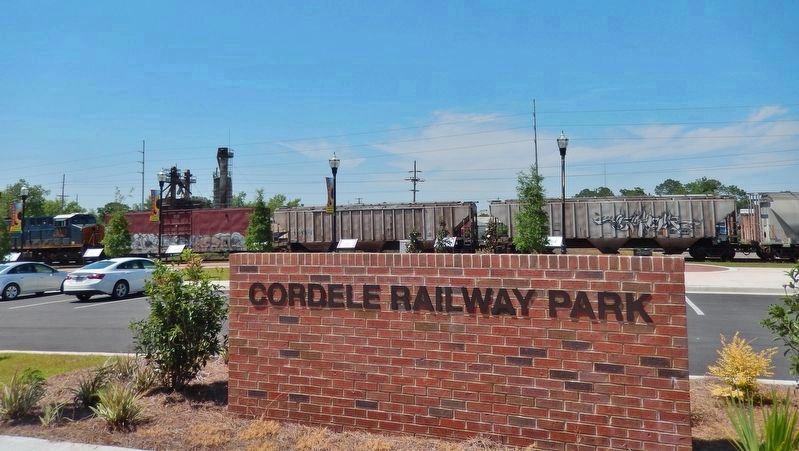
Photographed By Cosmos Mariner, May 8, 2021
6. Cordele Railway Park
Credits. This page was last revised on June 1, 2021. It was originally submitted on May 31, 2021, by Cosmos Mariner of Cape Canaveral, Florida. This page has been viewed 239 times since then and 35 times this year. Photos: 1, 2, 3. submitted on May 31, 2021, by Cosmos Mariner of Cape Canaveral, Florida. 4. submitted on June 1, 2021, by Larry Gertner of New York, New York. 5. submitted on May 31, 2021, by Cosmos Mariner of Cape Canaveral, Florida. 6. submitted on June 1, 2021, by Cosmos Mariner of Cape Canaveral, Florida.
